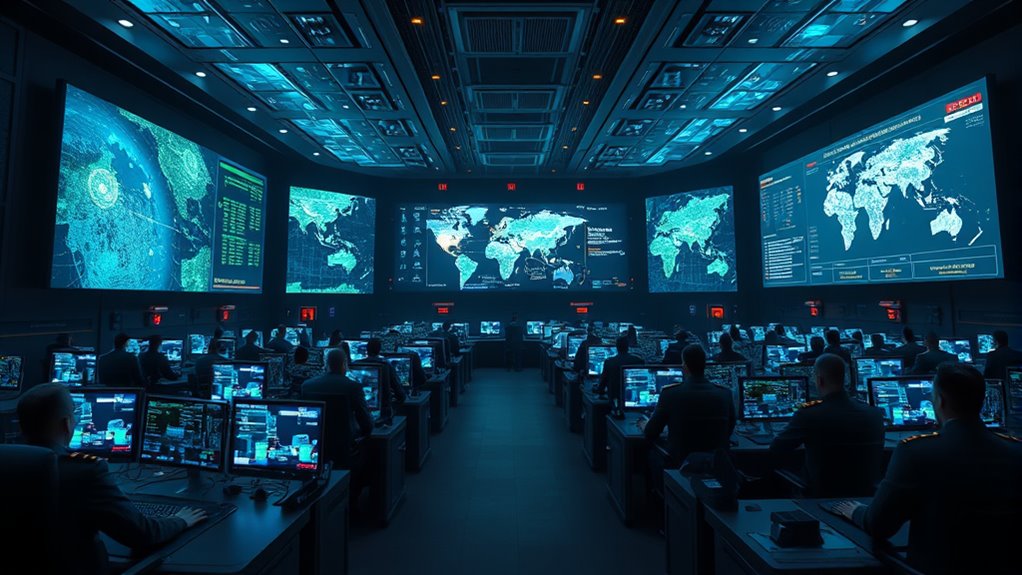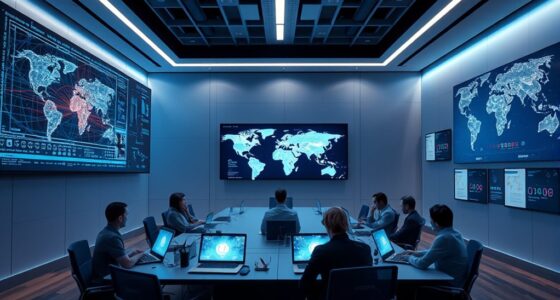The PLA Strategic Support Force acts as China’s central hub for modern warfare, integrating artificial intelligence and cyber capabilities to shape battlefield decisions. It manages space, cyber, electronic, and psychological warfare, enabling rapid data collection and analysis. AI drives faster threat detection and automated operations, shifting focus from reactive defense to proactive disruption. This force redefines battlefield strategy, emphasizing information dominance and technological innovation—if you want to explore how this impacts global military power, there’s more to uncover.
Key Takeaways
- The PLA Strategic Support Force (PLASSF) is China’s central hub for integrating AI into military decision-making and operations.
- It manages space, cyber, electronic, and psychological warfare domains to ensure rapid data collection and analysis.
- AI-driven systems within PLASSF enable proactive cyber and electronic warfare, disrupting adversaries before attacks occur.
- The force enhances China’s strategic and tactical capabilities by leveraging AI for faster threat detection and response.
- As the digital battlefield’s nerve center, PLASSF shapes future warfare through technological innovation and information dominance.

Have you ever wondered how modern militaries adapt to the digital age? The PLA Strategic Support Force (PLASSF) exemplifies this shift, serving as the nerve center for China’s military modernization. It’s not just about traditional combat anymore; it’s about integrating cutting-edge technology to gain a strategic edge. You see, the PLASSF is responsible for space, cyber, electronic, and psychological warfare—domains that are increasingly essential in modern conflicts. This force acts as the backbone for China’s military intelligence, surveillance, and reconnaissance capabilities, enabling rapid data collection and analysis across vast terrains and complex domains. Its role is to make certain that information flows seamlessly, allowing the Chinese military to make quick, informed decisions during crises.
What makes the PLASSF especially formidable is its focus on artificial intelligence. You might think of AI as just a tool, but in this scenario, it’s the core engine driving battlefield decision-making. AI algorithms process enormous amounts of data—from satellite imagery, cyber networks, and electronic signals—faster than human operators ever could. This speed allows China to identify threats, predict enemy actions, and deploy countermeasures almost instantaneously. It’s akin to turning the entire military into a highly responsive, intelligent organism that reacts in real-time to evolving situations. By automating routine tasks and enhancing strategic analysis, AI boosts the force’s agility and precision.
Furthermore, the PLASSF’s integration of AI transforms cyber and electronic warfare into proactive rather than reactive domains. Instead of merely defending against cyberattacks or electronic jamming, the force can now anticipate and disrupt adversaries’ systems before they fully activate. This proactive stance shifts the balance of power in modern warfare, where information dominance often determines victory. The force’s reliance on AI-driven systems also enhances its ability to conduct psychological operations, shaping perceptions and influencing the battlefield’s informational environment. With the capacity to manipulate digital narratives and conduct cyber espionage, the PLASSF becomes a sophisticated tool for strategic influence.
In essence, the PLA Strategic Support Force embodies the future of warfare—where technology, intelligence, and speed converge. It’s designed to outpace adversaries by leveraging the latest in AI and cyber capabilities, ensuring China remains a formidable player on the global stage. As a second person observer, you can see how this shift is transforming military doctrine, emphasizing the importance of digital prowess and technological innovation. The PLASSF isn’t just a military unit; it’s the nerve center that commands the digital battlefield, shaping the future of warfare through intelligent, integrated, and rapid response systems.
Frequently Asked Questions
How Does the SSF Coordinate With Other Chinese Military Branches?
You see that the SSF coordinates with other Chinese military branches through integrated command structures, joint exercises, and shared communication networks. It provides advanced AI and cyber support, which enhances the overall operational effectiveness of the PLA. By collaborating closely, the SSF guarantees seamless data sharing, synchronized strategies, and rapid decision-making across forces, ultimately strengthening China’s combined military capabilities and readiness for modern warfare.
What Specific AI Technologies Are Integrated Into the SSF?
You’re probably imagining a sci-fi flick, but the SSF actually integrates cutting-edge AI tech like machine learning, big data analytics, and autonomous systems. It’s not just about smarter drones or better cyber defenses — they’re developing neural networks that adapt in real-time, enhancing command decisions and battlefield awareness. So, while it sounds like a Hollywood script, it’s real-world military innovation, making their warfighting smarter, faster, and more unpredictable.
How Does the Ssf’s Role Evolve With Emerging Global Threats?
You see the SSF’s role evolving as it adapts to new global threats by increasing its focus on cyber warfare, electronic warfare, and AI-driven intelligence. You’ll notice it integrates advanced data analysis and real-time decision-making tools to stay ahead of adversaries. As threats grow more sophisticated, the SSF actively develops and deploys cutting-edge AI technologies to enhance strategic responsiveness, cyber defense, and information dominance, ensuring national security in an increasingly complex battlefield.
What Training Do SSF Personnel Undergo for AI Warfare?
You receive specialized training in AI warfare, focusing on advanced machine learning, cyber defense, and data analysis. You learn to operate AI systems, conduct real-time data interpretation, and develop strategies for AI-driven combat scenarios. Your training includes simulations, hands-on practice with cutting-edge technology, and understanding ethical considerations. This prepares you to effectively support and execute AI-based operations, ensuring you can adapt to evolving threats and leverage AI for strategic advantages.
How Is Information Security Managed Within the SSF?
You might think information security in the SSF is just about firewalls, but it’s much deeper. You’re protected through layered encryption, strict access controls, and continuous monitoring that adapts to emerging threats. Personnel undergo rigorous training on cybersecurity protocols, ensuring they stay alert to vulnerabilities. You’re also part of a dynamic system that regularly updates defenses, so your information remains secure even as cyber threats evolve rapidly.
Conclusion
As you witness the PLA Strategic Support Force become the AI warfighting nerve center, remember it’s not just about technology but the future of warfare. While machines process data instantly, human judgment remains essential. The contrast highlights that even in an era of advanced AI, your strategic insight and ethical choices are irreplaceable. In this high-tech battlefield, it’s your human touch that truly determines victory and peace.









